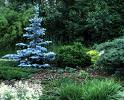Blue Spruce Tree Information
Images of Blue Spruce:






Blue Spruce grows in the following 8 states and provinces:
Arizona, Colorado, Hawaii, Idaho, Montana, New Mexico, Utah, WyomingInformation about Blue Spruce:
The Picea Pungens is commonly known as the Blue Spruce, Colorado Blue Spruce, Colorado Spruce, Pino Real as well as Silver Spruce.
The currently accepted scientific name of blue spruce is Picea pungens Engelm. . It is a member of the pine family (Pinaceae). There are no recognized subspecies, varieties, or forms. Blue spruce does not readily hybridize with other conifers . Throughout its range, it occurs with Engelmann spruce (Picea engelmannii Parry), but few if any natural hybrids are ever produced . Artificial crosses have produced small amounts of seed with low (0.3 percent) germination . Blue spruce, Engelmann spruce, and white spruce (Picea glauca) are sympatric in the Sweetgrass Hills of north-central Montana. Putative hybrids among all three spruce species have been reported . Approximately 38 horticultural varieties of blue spruce have been developed .Blue spruce is restricted to the central and southern Rocky Mountains. Its range extends from scattered populations in eastern Idaho and western Wyoming to better developed populations in Utah and Colorado. The range of blue spruce continues southward into Arizona and New Mexico . It occurs rarely in north-central Montana .Blue spruce occurs as dominant or codominant in small stands or as scattered individuals. In riparian settings, blue spruce is codominant with cottonwoods such as narrowleaf cottonwood (Populus angustifolia) or balsam poplar (P. balsamifera) . Blue spruce is more important in habitat type series of the central Rocky Mountains. Blue spruce series are restricted to cool, moist areas thoughout the southwestern mixed-conifer forests . Common codominants are Engelmann spruce, white fir (Abies concolor), and Douglas-fir (Pseudotsuga menziesii) . Blue spruce is often a long-lived seral species. It is seral in white fir, corkbark fir (Abies lasiocarpa var. arizonica), or fir phases of Engelmann spruce habitat types . It infrequently occurs in the spruce-fir subalpine zone . Some of the many publications that list blue spruce as an indicator or dominant in habitat or community types are: (1) Classification of the forest vegetation on the National Forests of Arizona and New Mexico (2) Classification of riparian vegetation of the montane and subalpine zones in western Colorado (3) Aspen community types of Utah (4) A physical and biological characterization of riparian habitat and its importance to wildlife in Wyoming .Some of the information provided here is attributed to:Pavek, Diane S. 1993. Picea pungens. In: Fire Effects Information System, [Online]. U.S. Department of Agriculture, Forest Service, Rocky Mountain Research Station, Fire Sciences Laboratory (Producer). , available at the USDA Fire Effects Information System (FEIS) website